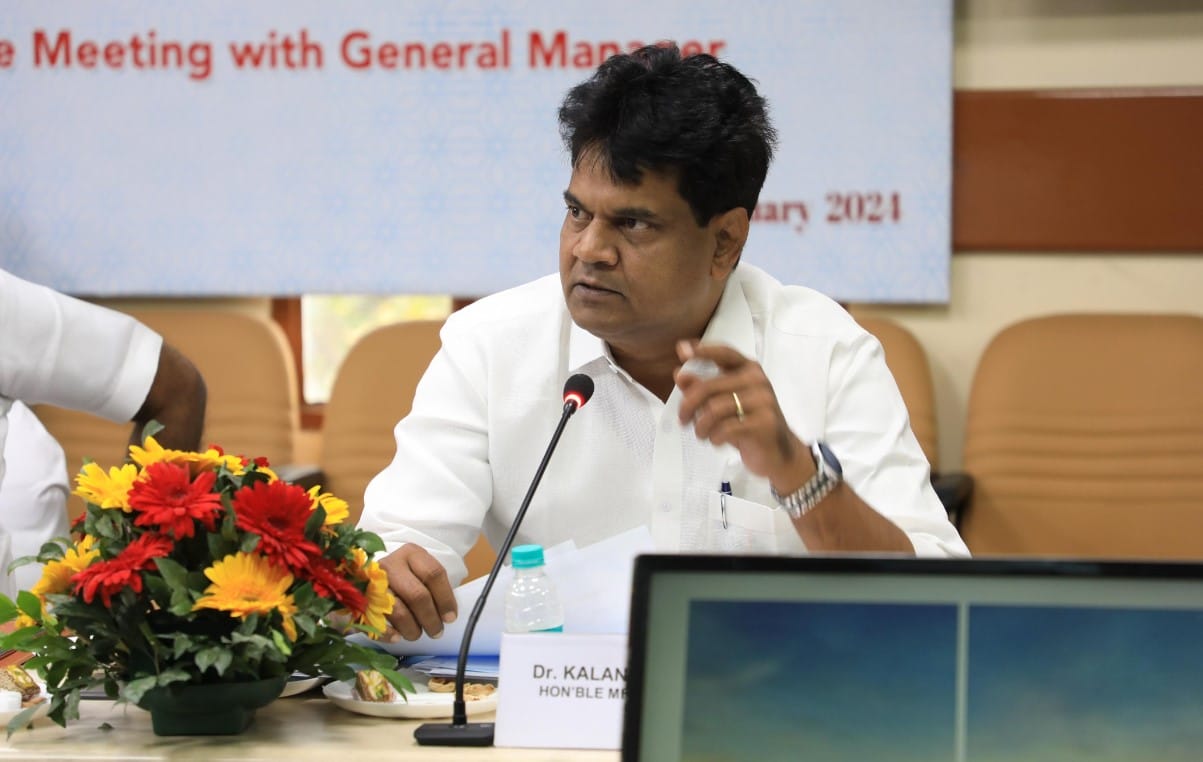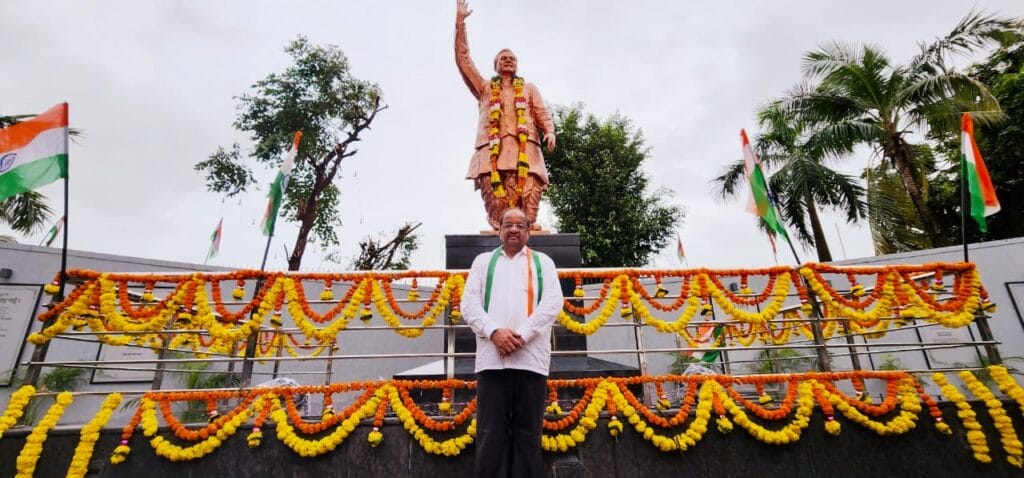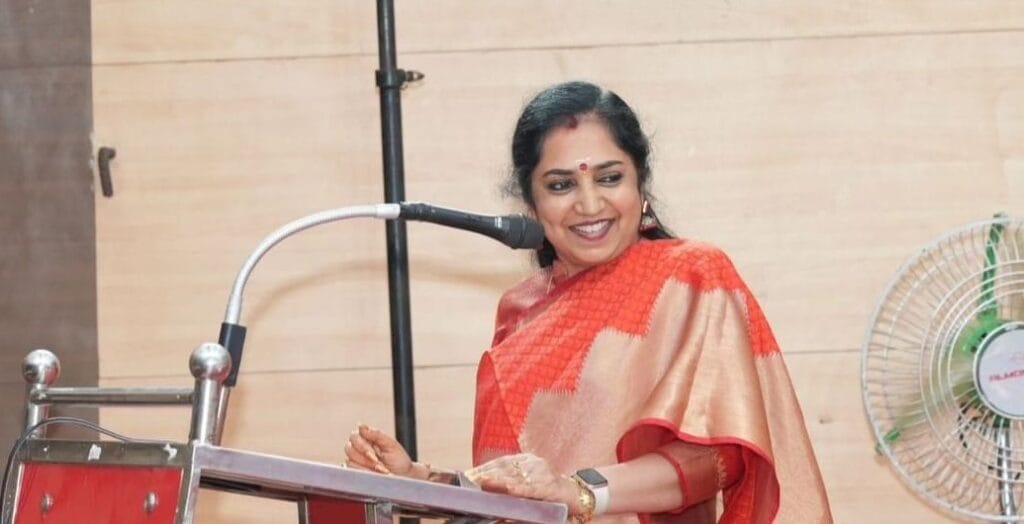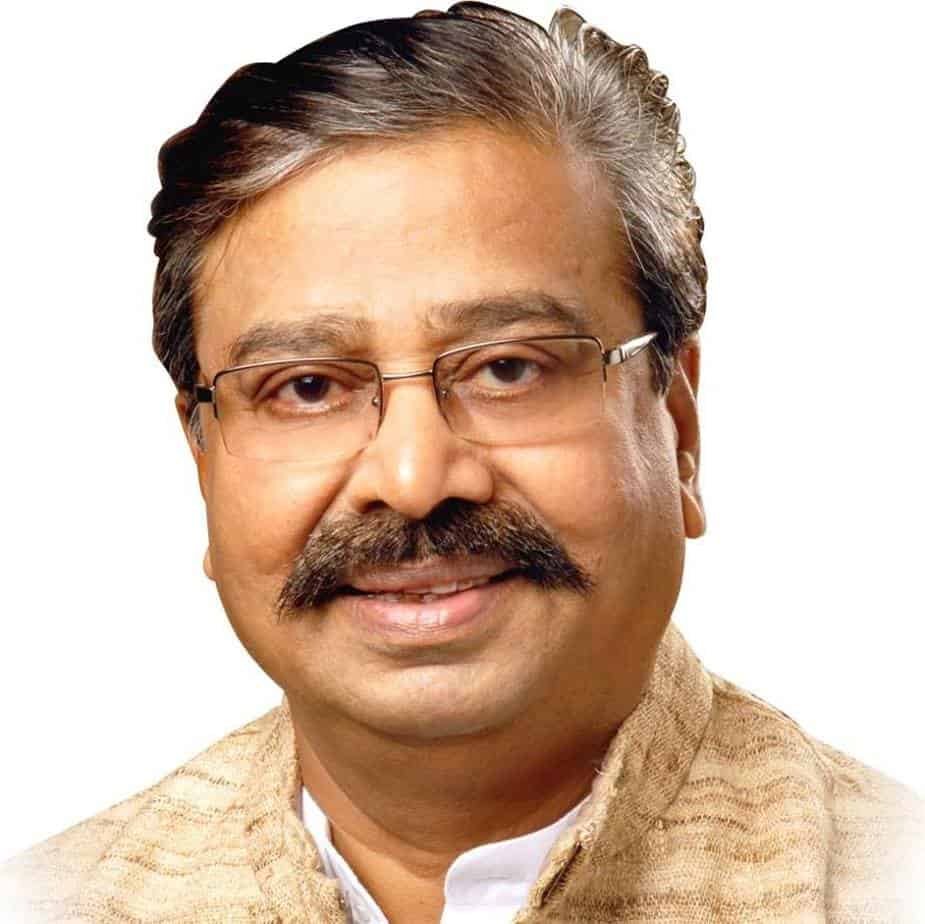The Mekedatu project has been proposed, opposed and has lain forgotten several times over the past many decades. However, the project idea is revived during every election. The current issue of water shortage in Bengaluru has particularly spurred interest in it again. Politicians from both the BJP and Congress in Karnataka are now using the project as an election campaign talking point.
Mekedatu, which is Kannada for goat’s crossing, is a rocky outcrop along the river Cauvery. It is situated within the Cauvery Wildlife Sanctuary, around three kilometres from the confluence of Arkavathy and Cauvery River.
Read more: Water shortage in Bengaluru: Families, schools, hospitals share their struggle
Mekedatu project timeline
In 2013, the Karnataka state government under Congress announced a balancing reservoir project in this stretch of the Cauvery to augment Bengaluru’s drinking water needs. The project would supply 4.75 tmcf (thousand million cubic feet) of drinking water to Bengaluru and surrounding areas and generate 400 MW of hydroelectric power.
The project would cost Rs. 9,000 crore, according to the 2019 Detailed Project Report (DPR) estimates. Over 5,000 ha of forest within the Cauvery Wildlife Sanctuary would be submerged for the project. The state government under Congress submitted a pre-feasibility report with the Central Water Commission (CWC) in 2017, which was rejected.
A second pre-feasibility report submitted in 2018 was accepted. The central body gave the state government in-principle clearance to submit a DPR. In the same year, Karnataka MPs across party lines held a protest demanding the approval of the project at the Parliament. Protesting MPs included current Lok Sabha candidates such as DK Suresh from Congress (contesting from Bangalore Rural) and Shobha Karandjale from BJP (contesting from Bangalore North).
In 2019, JDS-Congress coalition submitted a DPR for the Central Water Commission’s approval. The DPR was forwarded to the Cauvery Water Management Authority (CWMA), but no approval was forthcoming due to several objections by the Tamil Nadu government as well as its MPs across party lines.
Delays in implementation
However, the project has still not been approved. In 2021, BJP MP Tejasvi Surya and three of his fellow BJP MPs from Karnataka asked about the status of the project in the Lok Sabha. Bishweshawar Tudu, Minister of State for Jal Shakti, responded that the DPR had been taken up for discussion by CWMA but progress had stalled “due to the lack of consensus amongst party states,” i.e., Tamil Nadu and Karnataka.
In 2022, Congress MLAs undertook a much publicised ‘padayatra’ or march demanding that the Union Government approve the project. Siddaramaiah, who was the leader of opposition in the state at the time, accused the BJP government at the Centre for delaying the project. FIRs had been filed against ten Congress leaders, including Siddaramaiah and Krishna Byre Gowda for violating COVID-19 rules. The cases were withdrawn when Congress came to power last year.
In 2023, Janata Dal Secular (JDS) MP Prajwal Revanna, representing Hassan constituency, asked about the status of the project in the Parliament. The Water Minister had a similar response to this question. However, he added that the CWMA would take a call on the issue based only after the Supreme Court had decided on a Tamil Nadu state petition for Cauvery water.
Mekedatu promises during the campaign trail
With the elections in full swing, BJP and Congress candidates have taken to accusing each others’ parties for the delay. In February this year, Surya claimed that he would get the Centre’s nod for the project if the State government (under BJP at that time) could secure a No Objection Certificate (NOC) from Tamil Nadu’s politicians. It must be noted that the bottleneck for the project is Tamil Nadu government’s opposition.
Surya also accused the Congress of duplicity on the matter. He pointed out that DMK, a member of the INDIA alliance with Congress, had promised to stop the Mekedatu project in their manifesto. In response, Deputy Chief Minister DK Shivakumar said that the project would be implemented during Congress’ term in the state. He also accused BJP of politicising the issue and advised them to obtain the Centre’s nod instead.
Meanwhile, Siddaramaiah at an election rally claimed that the Congress candidate for Bangalore South Sowmya Reddy ‘s victory was crucial for the project’s implementation. Shobha Karandlaje, BJP candidate from Bangalore North, asserted three years ago that she and her party at the state would continue to push for the project.
Even former Prime Minister and leader of JDS HD Deve Gowda urged all Karnataka MPs across parties to support the project last month.
Environmental impacts of the project
It is clear that Karnataka politicians across party lines favour the project, while Tamil Nadu’s politicians appear to oppose it. However, environmentalists and conservation biologists warn that the project could have a massive impact on the Cauvery forests.
Speaking to Citizen Matters in March this year, Sanjay Gubbi, a wildlife biologist asserted that the project would lead to further loss of wildlife habitat. The location for the project is part of a critical elephant corridor. Loss of forest here would push elephants into further proximity to villages in Ramangara district, increasing conflict in the region, Sanjay explained.
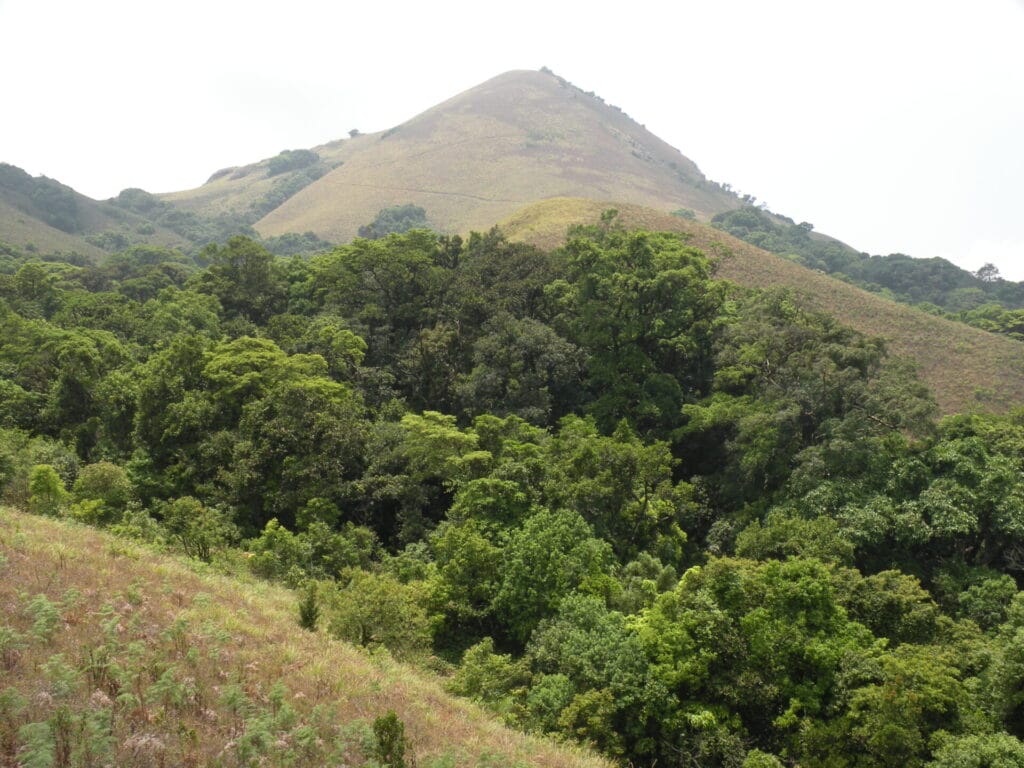
Urban water experts have also asserted that Bengaluru needs to look at restoring the city’s lakes, reusing wastewater particularly for construction and drinking water and implementing rainwater harvesting rules efficiently to make the city self-sufficient. However, Karnataka politicians have shown little interest in this alternative path to supply Bengaluru water.
Also read:
- The strange case of water in Bengaluru
- Lake Health Index reveals pollution concerns in Bengaluru’s water bodies
- Name: Arvind Sawant
- Constituency: Mumbai South
Two-term member of Parliament from Mumbai South constituency, Arvind Sawant, 73, started his political journey as a party worker with the Shiv Sena, when he started participating in agitations such as the Maharashtra- Karnataka border dispute protests.
He got into the trade union movement, when he founded the workers union of the Mahanagar Telephone Nigam limited (MTNL), where he worked.
Subsequently, he quit his job in 1995 to plunge into full-time politics and was nominated twice as member of legislative council ( MLC) from 1996-2010. He also played an active role in the Bharatiya Kamgar Sena (BKS), the labor wing of the Shiv Sena.
He has won from the Mumbai South constituency twice in 2014 and 2019, and continues to be on a strong footing as he prepares for his third Lok Sabha term. His opponent coalition, the Mahayuti alliance, is yet to announce their candidate with leaders such as former speaker Rahul Narwekar, legislator Mangal Prabhat Lodha and Yashwant Jadhav vying for the ticket.
In 2019, he defeated Milind Deora of the Congress by getting 52.64% of the votes. In 2014 too, he had defeated Deora by getting 48% of the votes.
Mumbai South constituency has strong pockets of the Gujarati and Muslim community since it includes the assembly constituencies of Colaba, Mumbadevi, Byculla, Malabar Hill, Worli and Sewri. The constituency is home to some of the richest citizens in the country including the Ambani’s, the Birla’s, the Singhania’s. It also includes the VIP zones that house the state ministers and major government and corporate offices.
It is a testament to his political prowess that he managed to win two terms from Mumbai South constituency, which is not exactly a stronghold of the Maharashtrian community.
A hardcore Shiv Sainik right from the beginning of his political career, he continues to be with the Uddhav Thackeray wing of the party.
Who is Arvind Sawant?
| Name | Arvind Sawant |
| Age | 73 years |
| Political Party | Shiv Sena (Uddhav Balasaheb Thackeray faction) |
| Educational Qualification | B.Sc , Bhavans College, Andheri from Mumbai University (1975) |
| Profession | Trade union leader, Social worker |
| Enrolled as Voter in | 31- Mumbai South, Serial no 621, in Part no. 80 |
| Arvindsawant@gmail.com | |
| Contact Number | 022- 24184488, 09869004488 (M) |
| Address | 3/87, Mithibai Bldg.,Aacharya Donde Marg, Sewrie, Mumbai-400015, Maharashtra |
Online presence:
- Website: https://arvindsawant.com
- Facebook: https://www.facebook.com/ArvindGSawant/
- Instagram: https://www.instagram.com/agsawant/
- YouTube: https://www.youtube.com/channel/UC23rAF-ZPMmXm3hhPh6E53Q
- Twitter: https://twitter.com/AGSawant
Read more: As coastal road project advances, fishers worry about boats and livelihoods
Criminal cases against Arvind Sawant
There are ten cases registered against Arvind Sawant under various charges of unlawful assembly (section 143), rioting (section 146), charged for wrongful restraint (section 341 ), causing assault using force to deter public servant from discharge of his duty (IPC Section-353) as also for causing damage to the amount of fifty rupees (IPC Section-427).
Assets and liabilities of Arvind Sawant
Details | Holdings in 2019 | Holdings in 2014 | Difference in 5 years |
| Movable assets | Rs 2.40 crore | Rs 1.05 crore | Rs 1.35 crore |
| Immovable assets | Rs. 0.31 crore | Rs 0.25 crore | Rs 0.06 crore |
| Total Assets (Movable + Immovable) | Rs 2.71 crore | Rs 1.30 crore | Rs 1.41 crore |
| Liabilities | Nil | Nil | Nil- |
Positions held by Arvind Sawant
He served as the union cabinet minister for Heavy Industries and Public Enterprises for a very short term from May to November 2019, before he resigned due to the split between the BJP and his Shiv Sena over government formation in Maharashtra.
- In 17th Lok Sabha:
- Union Cabinet minister for Heavy Industries and Public Enterprises (30 May, 2019 – 12 Nov, 2019)
- Standing Committee Membership — Railways (2020-2022)
- Standing Committee – Rural development and Panchayati Raj (Sept -Dec 2022)
- In 16th Lok Sabha (2014-2019):
- Member – Estimates Committee
- Member – Standing Committee on Petroleum and Natural Gas (2014-25)
- Member – Consultative Committee, Ministry of Communications and Information Technology
- 1996-2010: Member, Maharashtra Legislative Council
(Source: https://sansad.in/ls )
Performance in Parliament
Arvind Sawant is a committed parliamentarian and has 90% attendance and active participation in debates, both above national average.
17th Lok Sabha term:
| Term(2019-2024) | Attendance | No of Debates participated | No of questions asked | Private Member’s Bill |
| Arvind Sawant | 91% | 109 | 245 | 1 |
| National average | 79% | 39 | 192 | 1.3 |
| State (MH) average | 74% | 49.6 | 342 | 2.4 |
16th Lok Sabha term:
| Term(2014-2019) | Attendance | No of Debates participated | No of questions asked | Private Member’s Bill |
| Arvind Sawant | 98% | 287 | 480 | 1 |
| National average | 80% | 67.1 | 293 | 2.3 |
| State (MH) average | 78% | 68.6 | 607 | 4.8 |
He introduced private members bills on Introduction of the Designation of States As Sponsor of Terrorism Bill, 2017. In Parliament, he also raised the issue of the urgent need for approvals for redevelopment of the dilapidated chawls of Sewri on the Mumbai Port Trust land.
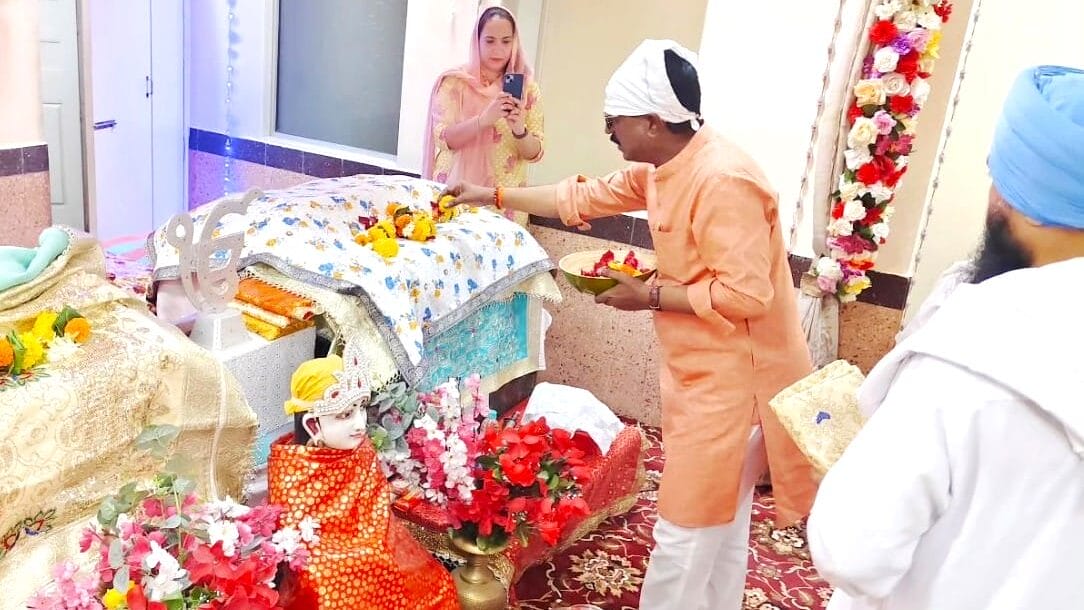
He also raised the issue of lack of safety measures of workers involved in the shipbuilding industry. He discussed the need to revive MTNL and BSNL and also pushed for giving classical language status for Marathi. He also demanded reservation of the Maratha community under the Other Backward Classes (OBC) category by extending the set reservation limit beyond 50%.
He has raised questions in Parliament about the number of road accidents in Maharashtra, demanding tagging of climate budget in the budgetary processes, protesting against the price hike of cooking gas and also sought questions about survey of slums in urban areas.
Arvind Sawant’s MPLADS Spending
Most of his MPLAD has been spent on community toilets , community centres and halls, construction of bus shelters and bus stops, common sitting area and work sheds, installation of fixed gym equipment, public libraries and reading rooms, drinking water pipelines etc. Out of 419 recommended works, 393 have been completed.
| 2019-2024 | Funds |
| Total entitlements | Rs 25 crore |
| Funds released by Govt of India | Rs 22.50 crore |
| Total expenditure | Rs 24. 06 crore |
| Unspent amount | Rs 1.00 crore |
| Date | Funds sanctioned | Gross expenditure |
| 2019-20 | Rs 5 crore | Rs 3.53 crore |
| 2020-21 | Rs 0 Crore | Rs 0.59 crore |
| 2021-22 | Rs 2 crore | Rs 0.49 crore |
| 2022-23 | Rs 5 crore | Rs 2.46 crore |
| 2023-24 | Rs 5 crore | Rs 0 crore |
| Total | Rs 17 crore | Rs 7.09 crore |
He has also funded new ambulances and repairs of schools in his constituency. Sawant says that his neighbourhood is impoverished and needs repairs and redevelopment.
Arvind Sawant in news
Over the past few weeks, candidature of Mumbai South Constituency has been in the news over various leaders trying to get a ticket. Even after Uddhav Thackeray’s Sena announced Arvind Sawant as the candidate for MVA alliance, the opponent candidates have not been announced.
Last year, Sawant was in the news when another Maharashtra leader Narayan Rane became aggressive in the Parliament and snapped at Sawant. He was recently acquitted in a 2005 case, where he, along with other Sena leaders were booked for protests against Narayan Rane, when he was expelled from the party.
He also met the President, as a part of delegation from Uddhav Thackeray’s Sena, urging to increase reservation limit as a solution to make reservations for Marathas possible.
People speak
Devendra Tandel, who was born and brought up in the Cuffe Parade Koliwada, says that his neighbourhood has failed to register any major changes either in terms of improvements of services or resources.
“Basic services like regular drinking water supply, cleanliness and sanitation continues to be a concern in our Koliwadas in spite of promises of being developed as tourist hubs. The tourists do visit our residential colonies but tend to take back images of these being ghettos. Our demand for redevelopment on our terms continues to evade us and it takes much resistance to fight us being termed as slums that need to be rehabilitated in flats,” he said.
Tandel added, “We also had to put up a long battle to get the government to introduce simple design changes in infrastructure projects like coastal roads to protect our livelihoods. A simple sensitive approach from the state could have prevented much bad blood between citizens and the State.”
He is also upset at the abject lack of support from the government towards the fishing support infrastructure like markets. “Existing prominent markets like Crawford Market were callously shifted to places like Airoli impacting our supply chain mechanism on the flimsy excuse of keeping Mumbai city clean and stench-free,” he points out.
Makarand Tasgaonkar from the BDD residents association, says that though the BDD redevelopment project is on schedule, people are uneasy and feel cheated as realisation dawns on them that they would have to live in houses that lack basic sunlight and ventilation.
“In the name of turning Mumbai into Shanghai or even a smart city, tall buildings that lack town planning norms and lack fire safety mechanisms are mushrooming all over the city. Projects like the Atal Setu have failed to reduce travel time except for those going to places like Uran or Alibaug. The textile hubs and labour population have been pushed out of the city and Mumbai is a pale shadow of its own self. People are seeing through this and this anger will reflect in the elections,” says Tasgaonkar.
Also read:
- Lok Sabha 2024: Know your MP — Gajanan Kirtikar, Mumbai North West
- Hanging Gardens, Mumbai’s century old treasure
- Lok Sabha 2024: Know your MP — Rahul Ramesh Shewale, Mumbai South Central
In North Chennai’s Vyasarpadi, candidates from different political parties contesting the upcoming parliamentary elections are on the last leg of their campaign around the neighbourhood. This is an oft-repeated tradition among politicians, especially in working-class localities, where they offer guarantees like electricity, water, monthly financial assistance, free buses, job opportunities and more, promised through government schemes.
In Vyasarpadi, like many other parts of the city, while everyone votes every year, the reasons for the consistent participation are not necessarily rooted in in-depth political knowledge about candidates. The incentives promised by politicians are important for overall development of the community, but these are often based on only one thing in exchange — their vote.
Once the votes are cast, the story is often the same across the city. After the 2019 Lok Sabha elections, the elected MPs were rarely seen on the streets again. It is no different in Vyasarpadi.
Given that the people of this area have considerable trust in Vyasai Thozhargal, we wanted to help build political awareness among residents so they could know more about the candidates they choose, the meaning of their votes, and the ideology of the people they vote for.
Read more: Elections 2024: What Chennai residents and civic groups want their MPs to address
For this, we went door-to-door and spoke to residents; to understand what they wanted from their MP; collected their demands and helped them identify the problems they would like to highlight. Through these methods, we as a community, put together a list of demands to hand over to each candidate. We have around 1,500 signatures and have already given the letters to the incumbent MP from DMK and a few other candidates.
Demands of the people of Vyasarpadi
Here are some of the demands put forward by the citizens living in Vyasarpadi:
- In December last year, all the roads were inundated for days, and no one came here to provide relief. We as a community came together to provide food, water and transport for residents. Many in the neighbourhood felt that the government and our elected representatives could have done more during a time of disaster. Residents demand a scientific and permanent solution for flood mitigation, which would prevent our homes from getting flooded every monsoon.
- Vyasarpadi residents say that drug and alcohol addiction are common among younger people, and urged the government to set up necessary facilities to rehabilitate those who are addicted to substances. They highlighted the need for quality education and good schools as a means to address this problem in the long term. The youngsters need guidance about careers and the job opportunities available to them. Moreover, liquor shops near schools must be relocated or banned.
- There is a need to improve the safety of women and children in the area, as many women have experienced sexual harassment. Residents want more streetlights and CCTV cameras on all streets, and police booths to be set up wherever necessary. Awareness programmes for men, sex education for children, and self-defence classes for women will also help address this problem.
- A key demand among residents is the issuance of pattas for the lands they occupy, to ensure they don’t get evicted from their homes. They have lived here for generations, but are yet to get land titles. The Tamil Nadu Urban Habitat Development Board asks for a beneficiary contribution of Rs 1.5 lakh from salaried residents for their homes. Residents want this to be scrapped.
- The Housing Board should install a motorised water pump to ensure water supply to all the homes. Many also suggested that a caretaker be hired for housing board colonies through government funds
- The Vyasai Thozhargal team asked many children and teenagers, who came to our tuition centre, about the changes they wanted in Vyasarpadi. Facilities for computer training and open spaces to play and exercise were some of the major demands. We also need a public library in our neighbourhood. We would like coaching centres that will help students with entrance exams and additional training for competitive exams.
The need to politicise and organise
When we went door-to-door to speak to people, we noticed that many residents were not aware of who they were electing — whether it was a member of Parliament, a member of the state assembly or a councillor. The lines between these designations were blurry and the election was seen as simply another occasion to cast votes, rather than an election to the Lok Sabha.
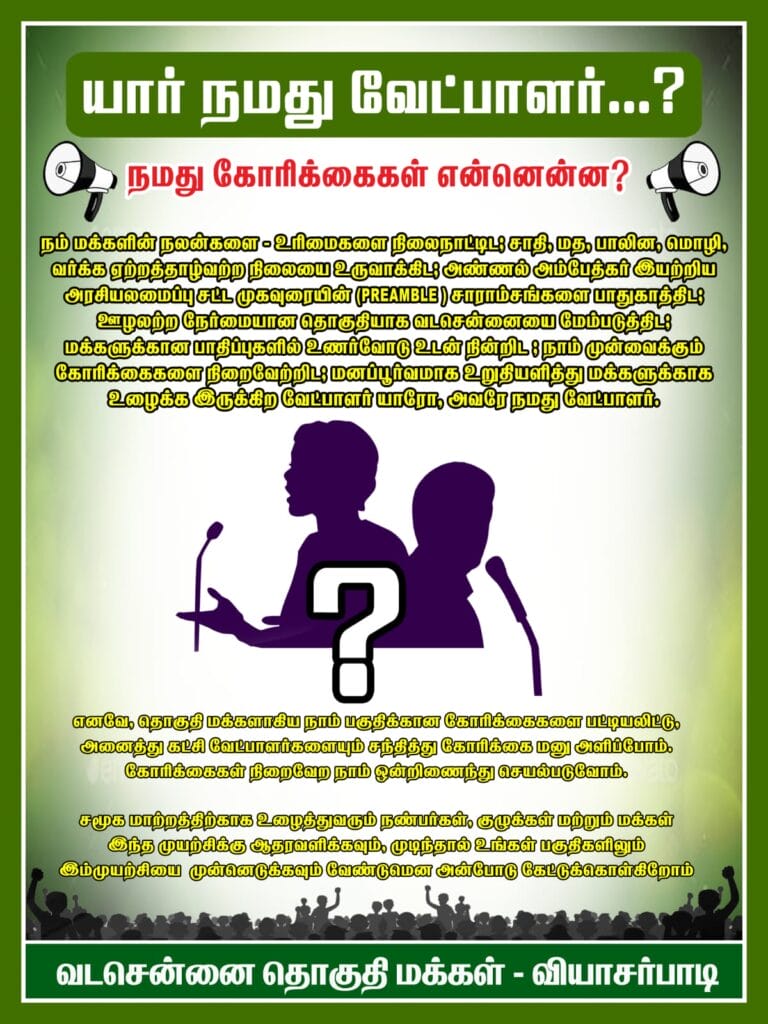
“What is this election? We just have to cast our votes again?” Someone asked us, dejectedly, when we went to their house. They appeared to have little faith in the process of voting. “Aren’t these MPs just powerful people who have control over us?” another resident asked.
This was a common idea among others we spoke to as well. We explained that the MP is an elected representative of the people, rather than a powerful authority figure who rules over others. Rather than people working for the MP, the MP is supposed to work for the people’s welfare. It was after hearing this, that many people started to talk about their demands to us.
Understanding Lok Sabha 2024 elections
We realised that people were not given adequate knowledge about bureaucracy, the civic and government systems in place, where their vote was going and how to make their demands in a way that could hold those in power accountable. The alienation from electoral and democratic participation was clear.
A key reason for this is a lack of adequate ‘fieldwork’ done by candidates, elected representatives and government authorities. Politicians, as mentioned before, are not often seen on the ground, in the neighbourhoods once the elections are over, and their engagement is often rooted in the transaction of votes for benefits during campaigning. Once the campaign is over, however, there isn’t much active research and engagement with those who have elected them.
This is why one of our final demands was that the elected representatives come and meet us regularly once they are elected.
It is also clear that candidates in the past haven’t made the effort to discuss the role they play as an MP, if elected, the roles and functions of the Lok Sabha, and the impact it has on the country and citizens’ lives. As a result, we felt the need to step in and do this work.
We also noticed that many residents didn’t feel confident about their choices, and asked us who they should vote for. Since we have worked with the children here, have carried out social work and know the people who live in Vyasarpadi, many residents trust our opinions. We, however, refrained from advising residents on their choice of candidates. The goal is to build the confidence and engagement of the people, to allow them to express their opinions, and to enter a sphere of democratic participation.
What was our approach?
We wanted the people to feel connected to the politics around them, to the elections they were being asked to take part in — we wanted to help ‘politicise’ those in our area. This is what we aimed to do:
Provide information on candidates, their promises, and their political parties. We also trained students from our area and team volunteers at our tuition centre to go to every house, educating people about the roles of MPs, the different rungs of the government, the candidates who were campaigning, and more.
Read more: Lok Sabha Elections 2024: Chennai North — Know your constituency and candidates
Encourage the people to identify their demands and put them together in a consolidated letter. We asked them what they felt they needed from their government and their future MP. We also asked them how they felt previous governments had treated and addressed existing problems in the area.
It was also important to encourage people to organise; to come together and demand together. This is why we asked each resident to join us when we made representations to each candidate. In these ways, people can feel like they are participating in the democratic process together, that they are making demands as a group, and that they have negotiating power against authorities in a democratic system.
Challenges along the way
While most see this work as important in ensuring a democratic election, we have been experiencing hurdles along the way. As the elections are coming up on April 19th, we have been having difficulties with the Election Commission in organising public meetings. This is because we have no affiliations with political parties or politicians.
While EC officials told us that the work we are doing is important, they suggested we carry out our awareness programmes once the MP was elected. But, this would defeat the purpose of creating voter awareness, so that people can make informed, educated, and politically-organised decisions for the good of their community.
People are the head of the country, as per the constitution. They should be allowed to meet and discuss candidates during election time. People must be aware that elected representatives and political parties are representatives of the public. This is why we politicise. To ask questions to MPs on the guarantees given, we must be aware of our power as participants in a democracy. Once this happens we can step closer to the ideal of democracy — where people rather than being voters will be participants in politics in the democratic system.
[Written with assistance from Savitha Ganesh, Engagement Associate, Citizen Matters.]
Also read:
- Chennai: Which parliamentary constituency does your ward fall in?
- Lok Sabha 2024: Voter guide to help you vote in this election
- Lok Sabha 2024: Know your MP — Dr Kalanidhi Veerasamy, Chennai North
As the Lok Sabha 2024 election is underway, political parties have released their election manifestos. What do the parties promise for us urban residents? How do they plan to make our cities sustainable and liveable?
Why cities matter
- In 2022, approximately a third of the total population in India lived in cities. The trend shows an increase in urbanisation by more than 4% over the last decade, which means that people have moved away from rural areas to find work and make a living in the cities.
- The demographic dividend of India is significant, with 65% of its population being below the age of 35 years.
- Unemployment rate in February, 2024 was at 8%, according to Centre for Monitoring Indian Economy Pvt. Ltd. (CMIE’s) Consumer Pyramids Household Survey.
Workers are increasingly migrating to urban areas that face various challenges related to natural resources, amenities and services. In light of this, we examine the political parties’ manifestos to understand their proposed solutions. Our analysis specifically focuses on their policies concerning healthcare, urban development, and water management.
Urban issue #1: Healthcare
When it comes to the health of urban populations and the major challenges that the sector faces, here are some of our key findings:
- Bengaluru: The city witnessed over 4,000 cases and several deaths due to dengue last year. At 4.08, Karnataka tuberculosis (TB) prevalence (P:N) ratio is far higher than the national average of 2.84, Bengaluru recorded a rise of 17% of the notified cases.
- Chennai: Despite experiencing heat-related health issues and high workloads, nurses in Chennai receive no support to brave extreme heat conditions. Climate change is wreaking havoc around the world. Now, research has found that climatic factors play a role in tuberculosis infections in Chennai.
- Mumbai: Mumbai witnessed an increase in monsoon maladies, rising TB – 65,617 cases were detected in Mumbai in 2022. Over 40% of Mumbai students suffer from anxiety, depression, and related mental health issues.
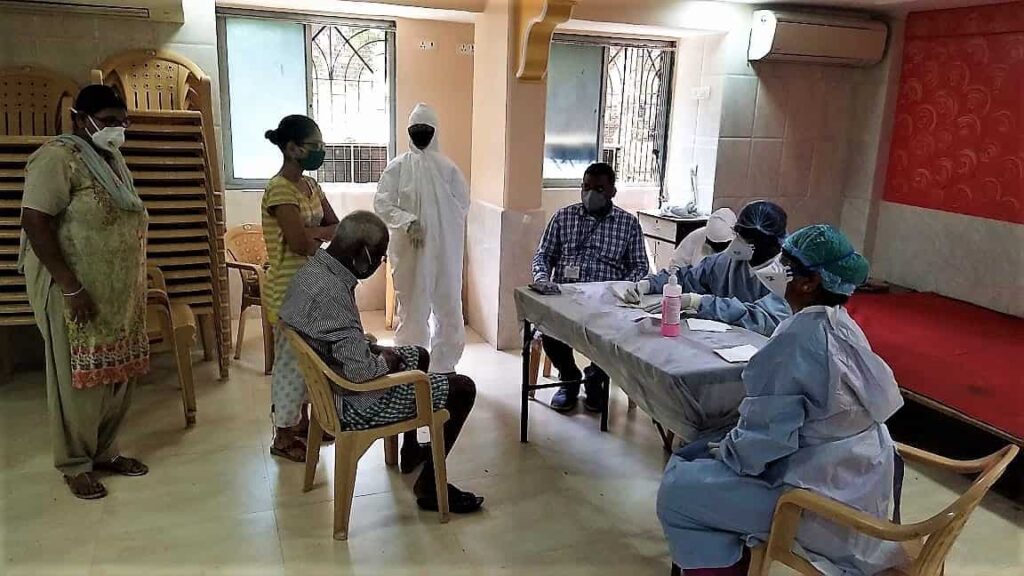
BJP has claimed that 34+ crore citizens are receiving free health insurance of Rs 5 lakh under Ayushman Bharat, but data proves otherwise.
According to a paper published by Ashoka University, however, Indian households spent an estimated Rs.120 billion on health and healthcare-related services in November 2022. Government spending on healthcare remains low in India as compared to global standards, resulting in high reliance on the private sector and high proportions of out-of-pocket expenditures by households. Compared to the global average of 18%, Indians spend close to 55% of all expenditure on health, which is financed out-of-pocket.
So, what are the key agenda items for the sector that the two main contenders in the upcoming general elections — the Bharatiya Janata Party (BJP) and the Indian National Congress (INC) — have laid out in their manifestos?
BJP promises on health and related issues
- Expand the Ayushman Bharat Yojana to cover senior citizens.
- Strengthen and expand Ayushman Bharat programme
- Expand schemes for women to prevent and reduce anaemia, breast cancer, cervical cancer and osteoporosis; a focused initiative to eliminate cervical cancer
- Make sanitary pads available at 1 Rupee
- Strengthen traditional practices, including yoga and meditation. Enhance the scope and coverage of mental health initiatives like Manas and Manodarpan
- Enhanced training capacity for paramedics, technicians, pharmacists and nurses
- Support ‘Bharatiya’ vaccine manufacturers and biopharma companies to boost production and distribution
- Emergency and Trauma Care Mission for immediate and effective care to trauma patients
- Increase the number of UG and PG seats in medical education. Strengthen AIIMS network
- Work towards elimination of malnutrition among tribal children and of sickle cell anaemia
…and more
INC promises on health and related issues
- Increase budget allocation for health annually, to achieve 4% of total expenditure by 2028-29
- Rajasthan model of cashless insurance up to Rs 25 lakh
- Maternity benefits for all women and mandate paid maternity leave by all employers
- Double the number of Anganwadi workers and creation of additional 14 lakh jobs
- Double central government contribution to the pay of frontline health workers (such as ASHA, Anganwadi, Mid-Day Meal cooks, etc.)
- National Mission on Immunisation to ensure 100% of children are immunised within 5 years of age
- Extend the mid-day meal scheme up to Class XII to fight nutritional deficiency
- Fill all vacancies in medical and paramedical posts in public health institutions and in medical colleges in three years; establish a government medical college-cum-hospital in each district
- Review the National Medical Commission (NMC) Act and ensure full autonomy for the NMC to carry out the obligations under the Act
- Support all medical systems and scrutinise all medicine manufacturers to ensure quality and good manufacturing practices
Urban issue #2: Water management and sanitation
According to a Central Ground Water Board (CGWB) report, ‘Dynamic Ground Water Resources Assessment of India – 2022‘, the overall stage of groundwater extraction in the country is 60.08%! According to the World bank, India is home to 18% of the world’s population, but only 4% of its water resources, placing it among the most water-stressed countries in the world.

Here is how the water situation is in cities we looked at:
- Bengaluru: Karnataka has declared drought in 223 out of 240 taluks. Bengaluru has been facing severe water shortage forcing The Bangalore Water Supply and Sewerage Board (BWSSB) to implement restrictions, such as banning the use of portable water for non-potable use, and implementing measures to conserve water such as fixing aerators and re-use of treated water for construction, etc. In 2022, the city experienced severe flooding.
- Chennai: Illegal extraction and poor rainwater harvesting affect groundwater in Chennai. There are issues with water supplied from the Nemmeli desalination plant. A city plagued with cyclones and other weather vagaries is in urgent need for an integrated water management system to prevent floods and drought.
- Mumbai: Water crisis is deepening gender inequality. Despite promises by political parties, annual Mumbai floods are still a problem. The impact of climate change in Mumbai will increase, according to a new report.
What do the manifestos of BJP and INC say about solving water-related issues?
BJP agenda for water-related issues
- Revive water bodies as part of overall thrust on sustainable and people-friendly cities
- Create water-secure cities, leveraging best practices for wastewater treatment, aquifer recharge and smart metering for bulk consumers.
- Create a curriculum for urban governance that will include urban water management
- Revitalise rivers
- Support state governments in developing systems to treat water contamination; ensure comprehensive water quality management
- Ensure clean drinking water, Har Ghar Nal se Jal, for all households; use technology to reduce water wastage
INC agenda for water-related issues
- Work with state and local governments to stop discharge of effluents into rivers and water bodies; Discharge of any kind of effluent into rivers will be prohibited by law
- Expand the remit of Ministry of Jal Shakti and bring all water-related activities and departments under one authority.
- Implement a nationwide plan to provide potable water in all cities
- Mandatory water harvesting; Desalination plants in coastal areas
- Collaborate with states to create comprehensive underground drainage network and safe disposal of sewage in all towns and municipalities in 10 years
- Focus on storage in dams and water bodies, and on replenishing groundwater. Create a large participatory water management programme
Urban issue #3: Overall city governance
Urban development in India is a multifaceted challenge, encompassing the need for improved mobility and sustainable transportation, robust infrastructure, and efficient waste management.
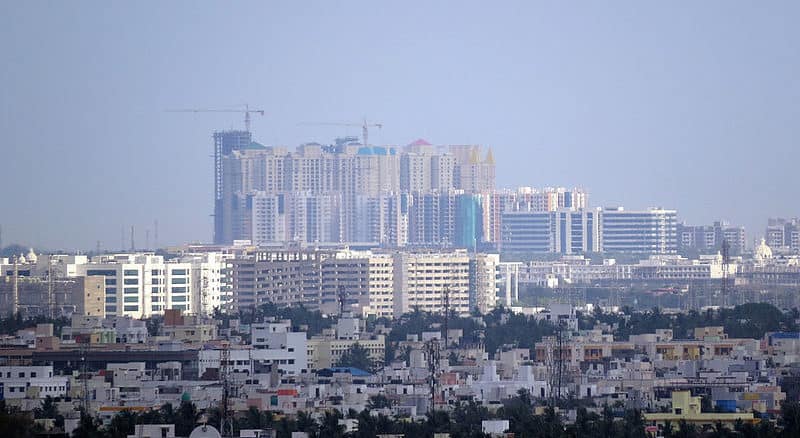
Here are some of the key issues plaguing our cities:
- Bengaluru: A long pending, yet key demand has been the implementation of the 74th Amendment. The last municipal election was in 2015, the city has been functioning without an elected municipal government for the last 4 years now. Poor implementation of Smart city projects.
- Chennai: Civic organisations in Chennai have voiced several concerns and put forward demands for clean air, better mobility, housing and fisher welfare.
- Mumbai: This city, too, has been waiting for civic body elections for over two years now. Several Metro lines have been commissioned, but it has not resulted in reduced traffic and last mile connectivity continues to be a problem for Mumbaikars. Toll charges are adding to their travel costs.
The Comptroller and Auditor General of India (CAG) Audit report flagged urban local bodies (ULBs) as being powerless and cash-strapped. ULBs, of which the Mayor is the head, are powerless. The Mayor’s short tenure further prevents him/her from making any meaningful contribution. The 74th Amendment was meant to devolve powers to the ULBs but successive governments have done little to implement it; some manifestos even promise devolution of powers, but only on paper.
Centre-State relations in India have been a topic of intense discussion, particularly with some southern states expressing discontent. The issues often revolve around financial allocations, and the perceived encroachment of the Centre on state powers. Concerns abound over the distribution of resources.
But even with these issues calling for urgent attention, the manifestos of the two largest parties seem to lack a clear roadmap on many of the gaps that cities experience today. Here are their key agenda items for overall urban improvement:
BJP agenda for improving urban life
- Expand the metro network in major urban centres ensuring last mile connectivity
- Extend current redevelopment of 1,300+ railway stations to all other major and medium-sized stations
- Expand RRTS services and launch other regional connectivity programmes to major cities
- Launch of a Super App to provide all train-related services to users in a single app.
- Construct ring roads around major cities to improve mobility and decongest cities.
- Increase the fleets of Electric Vehicles and establish more EV charging stations.
- Create unified metropolitan transport systems that integrate multi-modal transport facilities and reduce commute time in cities.
- Implement AI technologies for traffic management and transport efficiency.
- Extend PM-eBus Seva across cities to provide affordable and safe transport to citizens.
- Continue eliminating open landfills to manage all kinds of waste being produced through ‘Waste to Wealth Mission’.
- Strengthen land records by creation of the Digital Urban Land Records System.
- Encourage states and cities to create a modern set of legislation, by-laws and urban planning processes using technology.
- Create a fresh curriculum for urban finance, urban infrastructure, urban environmental protection, urban water management, urban transport and more.
INC agenda for improving urban life
- Launch an urban employment programme guaranteeing work for the urban poor in reconstruction and renewal of infrastructure
- Make a law to specify and protect the rights of gig workers and unorganised workers and enhance their social security
- Propose laws to regulate the employment of domestic help and migrant workers, and ensure their basic legal rights
- Augment transport facilities and connectivity between rural areas and the nearby towns/cities so that people may live in rural areas and work in urban areas
- Implement a comprehensive plan for multi-modal urban public transport
- Review existing policy on Road Tolls and apply reasonable formulas to determine the toll amount and the period of levy for each stretch of the road
- Amend laws to grant more executive, financial and administrative powers to the directly-elected Mayor/Chairperson for effective governance in urban local bodies. The administration will be accountable to the Mayor/Chairperson and the Council
- Support the construction of a twin city near an existing city but separated by a clear green and no-construction zone between the old and new cities to regulate mindless expansion of existing cities.
Also read:
- Bengaluru, here is where all the taxes you pay end up
- Elections 2024: What Chennai residents and civic groups want their MPs to address
Candidate lists, MP profiles, interviews, voter guide, choosing an MP, polling booth info, news, analysis and data… watch this space as we update this continuously over the various phases of voting in the Lok Sabha elections 2024
Constituencies & Candidates
Get to know your constituency, and who your candidates are.
Phase 1: April 19th
Phase 2: April 26th
- Bangalore North
- Bangalore Central
- Bangalore South
Phase 5: May 20th
- Mumbai North
- Mumbai South
- Mumbai North East
- Mumbai North West
- Mumbai North Central
- Mumbai South Central
Candidate Interviews & Profiles
Chennai
Resources
Voter Guide
All you need to know before you cast your vote
How do you check if your name is on the electoral rolls? How do you locate your polling booth? Who are the candidates in your constituency? Can you still vote if you don’t have a voter ID card?
- Voting from home in Lok Sabha elections 2024: Eligibility, process and other rules
- Find your polling station
Find your constituency
How to vote
MP’s role and responsibilities
- Voters’ dilemma: Who should my MP be? (Archives)
- Tips to choose the right MP (Archives)
- What makes your MP a true people’s representative?
- MPLAD spend
Understanding Political Parties (Manifestos)
On the ground
- Bengaluru politicians across party lines bat for Mekedatu project
- Creating voter awareness for the Lok Sabha elections: Examples from Vyasarpadi in North Chennai
- Elections 2024: What Chennai residents and civic groups want their MPs to address
- How political parties are responding to the call to ‘Make Parliament Great Again’
- PM SVANidhi Scheme: 63 lakh loans given, but to whom?
Bangalore North is a Parliamentary Constituency that includes eight Legislative Assembly segments. The segments include: K. R. Puram, Byatarayanapura, Yeshwanthapura, Dasarahalli, Mahalakshmi Layout, Malleshwaram, Hebbal and Pulakeshinagar. All the Legislative Assembly segments are a part of Bangalore Urban district.
Bangalore North held its first elections in 1951. The Constituency has had several names over the years. In 1957 and 1962, it was known as Bangalore City. In 1967 and 1971, it formed a constituency jointly with Bangalore South and was known as Bangalore. In 1951 and every election post 1977, it has been designated as Bangalore North. Of the 17 elections held in this constituency, Indian National Congress (INC) has won a majority of 12 elections. As of the last elections in 2019, the MP of this constituency was D V Sadananda Gowda from the Bharatiya Janata Party (BJP), who won the elections by over 1.4 lakh votes.
Constituency map

At a glance
| Constituency Name | Bangalore North |
| Number of voters (2019) | 28,48,402 |
| Male voters | 14,81,401 |
| Female voters | 13,66,503 |
| Other voters | 498 |
Find your polling booth:
Use your EPIC number in the voter id cards to find the booth information here.
Key candidates contesting in the Lok Sabha 2024 elections
| Candidate | Sex | Party | Age | Education | Criminal cases | Total assets | Total liabilities |
| Shobha Karandlaje | F | BJP | 57 | MA Social Service | 5 | Rs. 13.89 crore | Rs. 4.06 crore |
| M. V. Rajeev Gowda | M | INC | 61 | PhD | 0 | Rs. 134.03 crore | Rs. 1.49 crore |
| Nirmala H. L | F | SUCI (C) | 35 | M.SC Physics | 0 | Rs.2.38 lakhs | Nil |
The full list of the candidates and their affidavits can be accessed from the ECI web portal.
Read about the incumbent MP D V Sadananda Gowda here.
Candidates in the news
Shobha Karandlaje: Shobha contested the 2014 Indian general election from Udupi Chikmagalur Constituency and won by a margin of 1.81 lakh votes. In 2019, she won consistently for the second time from the same constituency with 6.26% of votes.
She was praised for her performance as the Minister for Rural Development and Panchayat Raj (RDPR) in the BJP-led Karnataka government. During her tenure, the Ministry of RDPR was awarded as the No. 1 State in India in Rural Development and Panchayath Raj.
In 2020, six girls from North-East India, who worked in the hospitality department in Bengaluru, were asked to vacate their premises by police officials. Karandlaje visited the place of the girls the very next day and demanded stringent action against those who harassed the six girls from Northeast. In her tweet, she stated, “Visited our NE Sisters along with PI Sri Jagadeesh, assured them of their protection & every needed help. Those who harassed our sisters have been arrested by police, strict action will be taken against everyone who attacks our NE people. We are all with our people of North East.”
The Kerala Police had filed a case against Karandlaje for promoting religious enmity after she put up a post on social media alleging that Hindu families in Malappuram were not provided water because they supported the amendments to the Citizenship Act, News18 reported.
Rajeev Gowda: The Bangalore North Congress candidate Rajeev Gowda, a politician and academic, has been active in politics since 2000. In 2023, he was appointed the vice chairperson with cabinet rank of the State Institute For The Transformation of Karnataka (SITK).
Ahead of Prime Minister Narendra Modi’s visit to Karnataka this month, Rajeev Gowda questioned the centre’s allocation of funds to the state. He highlighted that funds promised by the Centre have not been allocated to several areas, such as the upper Bhadra project, allocations mandated by the 15th Finance Commission and funding for the Peripheral Ring Road.
“We want to welcome Prime Minister Modi to Karnataka with a few key questions. Number one, why have you not given us the adequate funds? There are three, or four areas. You have not released the funds that are due to the upper Bhadra project that was announced in the budget,” he said as quoted by the media.
In an interview with Times of India, Gowda said that he chose Bangalore North to contest from as he felt a local connection with it having grown up here. He said that he is “relieved” that his opponent is Shobha Karandlaje as he has the advantage of being a local Vokkaliga against a coastal Vokkaliga. He added that there is discontentment against Shobha’s candidature within BJP, while he has a conducive environment with many Congress MLAs, including two ministers, backing him.
Karnataka CM Siddaramaiah exuded confidence in Gowda, saying that he is qualified and has good chances of winning. Expressing his views about free education, Gowda said, “We are proposing a universal guarantee for free education in public schools irrespective of the child’s economic background. We have promised a six per cent allocation of the GDP towards education. I don’t think funding this promise will be a problem. I think this is a crucial investment and there is no question of bleeding the economy.”
Nirmala HL: She is a Socialist Unity Centre Of India (Communist) candidate for Bangalore North. She has completed her M.SC in Physics and studied in Bangalore University.
Past election results
| 2019 | Candidate | Sex | Party | Age | Vote Share (%) |
| 1 | D. V. Sadananda Gowda | Male | BJP | 71 | 52.87 |
| 2 | Krishna Byregowda | Male | INC | 50 | 43.41 |
| 3 | NOTA | – | – | – | 0.75 |
| 2014 | Candidate | Sex | Party | Age | Vote Share (%) |
| 1 | D. V. Sadananda Gowda | Male | BJP | 71 | 52.95 |
| 2 | C. Narayana Swamy | Male | INC | 76 | 36.01 |
| 3 | Abdul Azeem | Male | JD(S) | 61 | 6.83 |
Constituency key issues
Though the Bruhat Bengaluru Mahanagara Palike (BBMP) has been allocated Rs. 30 crore for Sankey Tank Development, there continues to be issues. Walkers express concerns over dead fish in the lake. There have been reports of garbage and sewage entering the lake as well as increased levels of toxicity of the water. The toilets in the premises are also in poor condition. Recently, concerns have been raised over the construction of a footbridge at Sankey Tank, which is supposed to connect Sadashivnagar and Malleshwaram 18th cross. Conservationists and residents say there is no need for a bridge and that the lake ecology should not be disturbed.
The former state government filed 70 FIRs against those who protested against the construction of the Sankey Road flyover. Residents contend that the flyover will not be decongesting the road, but will result in the felling of several trees, which is detrimental to the environment.
In Bangalore North, several grade separators are being constructed to address traffic congestion. These grade separators are part of efforts to alleviate traffic issues in the area. BBMP proposed a flyover at Gokula Road Junction at a cost of Rs. 40 crores. However, if the previously completed Yeshwanthapura flyover was extended by another 500 metres to bypass the Gokula Road junction, there would have been no need for a flyover at Gokula.
Read more: Close shave for Palace Orchards: Sankey road flyover would sound a death knell for heritage trees
Hebbal constituency, especially the Hebbal main road and the neighbourhood close to the airport road are infamous for traffic congestion and deadly accidents. Hebbal main road is a major junction for vehicles commuting to and from the airport. Poor public transport connectivity and walkability are among the most important concerns in Hebbal. Walkers in K. R. Puram have complained about the lack of a foot over bridge between K. R. Puram metro station and the railway stations to make crossing the road less risky.
Twenty six lakes in Byatarayanapura are supposed to be rejuvenated, but several lakes have been allegedly encroached or polluted by sewage. Residents of this constituency constantly face stormwater drain encroachments and poor waste management.
Residents of Mahalakshmi layout face shortage of drinking water, flooding of low-lying areas and clogged drainage pipes. Traffic continues to be a concern as well. Peenya Industrial Area, being one of the largest industrial areas in South-east Asia, has contributed significantly to the growth of Bengaluru. However, the area suffers from air and soil pollution, and contamination of water sources.
Pulakeshinagar faces issues of poor sanitation, inadequate water supply, problems with drainage, housing issues, poor waste management, inadequate drinking water, lack of streetlights, and drug abuse. Garbage continues to remain a major concern in this constituency. Residents have complained about garbage dumping in Frazer Town and construction debris in Pulakeshinagar and Coles Road.
Poor roads and garbage remain as major concerns in Yeshwanthapura. Several wards in the constituency still struggle with bad roads. Residents of Herohalli and Doddabidarakallu have reported mud roads being washed away by heavy rains. Four of the seven BBMP waste to energy plants lie in this constituency, in Kannahalli, Seegehalli villages, Lingadheeranahalli and the Doddabidarakallu ward. Residents have protested against all four plants because of foul smell and groundwater pollution.
Also read:
- Sankey road widening: A project that doesn’t die
- How a foot-over-bridge can slash travel time and pollution in Yeshwanthpur
- How to contact BBMP Dasarahalli zone officials?
Once a year, I inadvertently overhear someone wondering aloud about the sea level while crossing the Mahim or Thane Creek bridges without realising that the sea has tides. Similar conversations are heard at the beaches too.
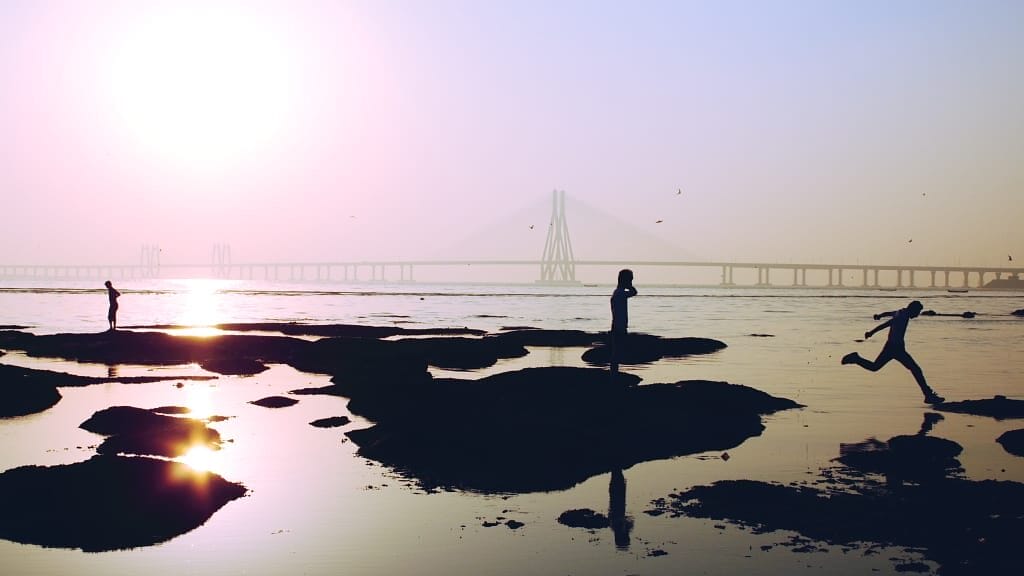
Not being aware of tides often leads to lovers being stranded on the rocks along the coast, or even people getting washed away by waves during the monsoons. People regularly throng the sea-fronts of Mumbai – sometimes the beaches, sometimes the promenades, but may not always pay attention to the sea.
When the floods arrive, and in times of distress, we remember water, we think of nature, we wonder how this water could possibly drain out, and are reminded of the sea.
Our disconnect from the everyday of the sea, is not surprising. Over time our eyes are focused on our daily survival, our jobs, our responsibilities– and so we become oblivious to what surrounds us: water.

Beaches, an integral part of Mumbai
We forget the fact that we live on a small island surrounded by the sea and the two large creeks into which the Ulhas River empties. However, the shoreline is fast disappearing both physically and from our memories.

Long before all our mobile phones showed the time, our lives were dictated by the master clock used by the railways, helping the city run like clockwork.
At the beaches, however, it is not the railway clocks or even the mobile phones, that make the plans. This place where the city stands, is dictated by the daily dance of the tides – high and low.

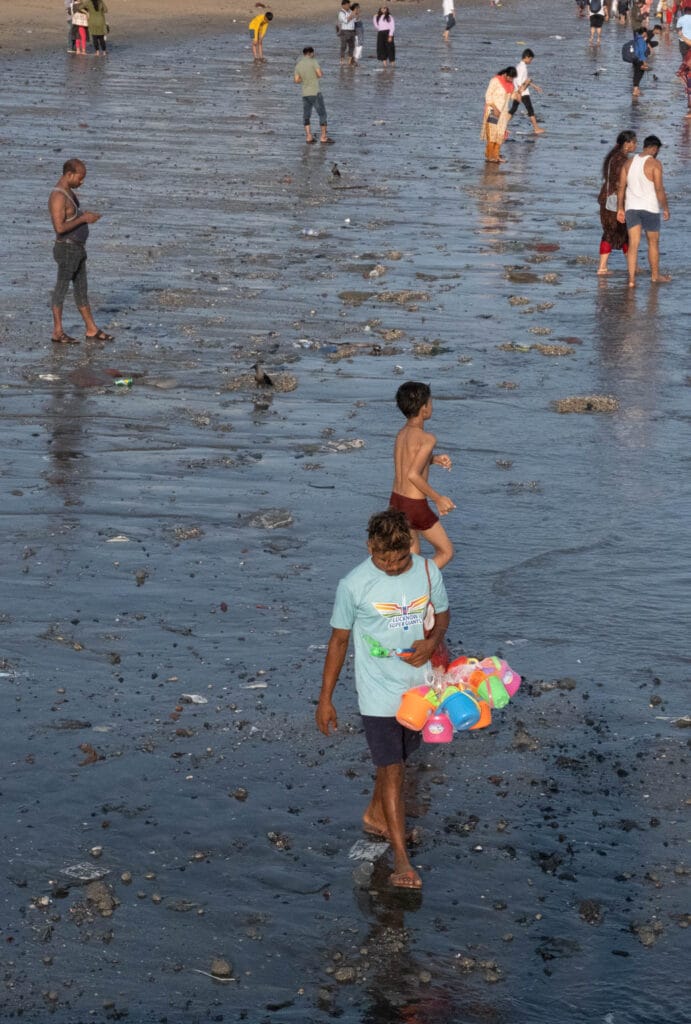
Read more: In photos: The story behind waterlogging in Mumbai’s Kranti Nagar every monsoon
Training the lens on invisible side of beaches
As a photographer of city life, I often found myself on Mumbai’s beaches, shadowing fishermen or beach-goers, curious about their interactions with this invisible edge of the city.
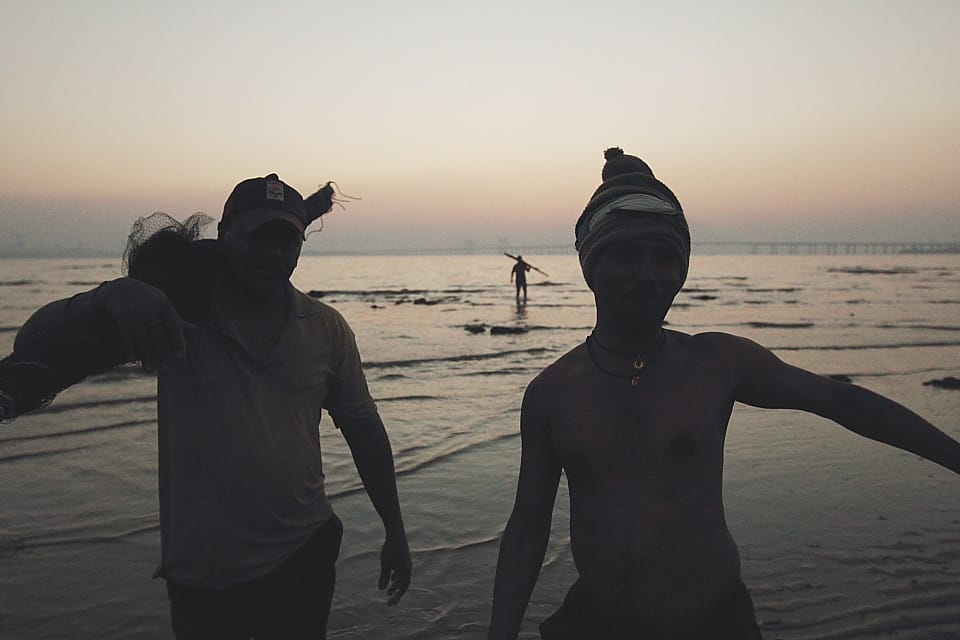
Read more: Photo essay: “Araam” season in Dharavi’s Kumbharwada as potters cope with monsoon
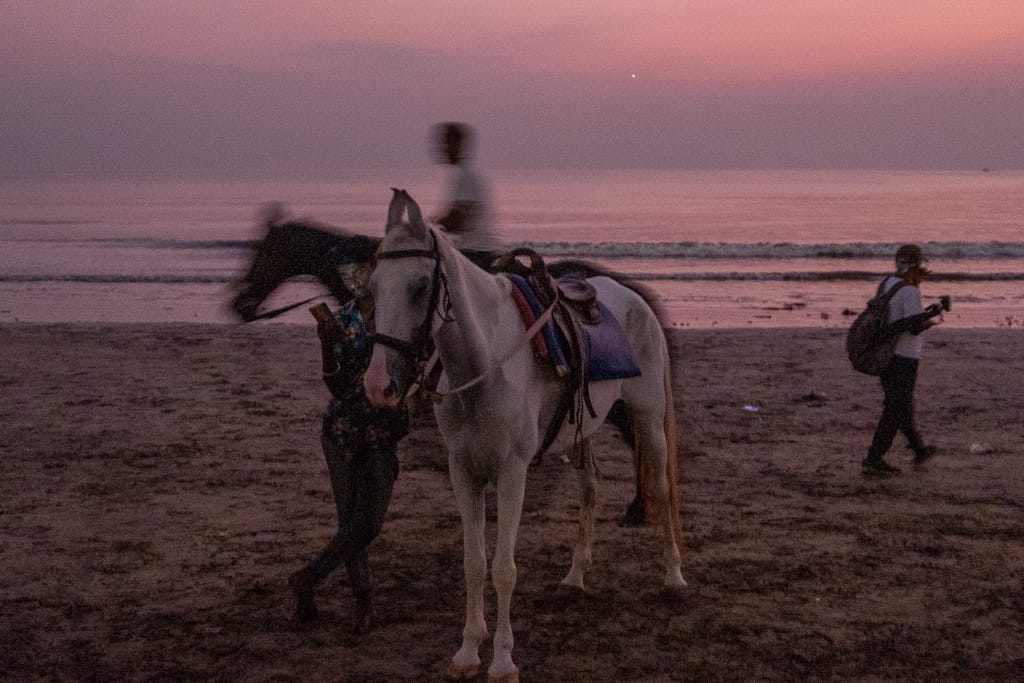
While people and objects fill my pictures, it is the scenes that I try to capture – scenes that tell a story.
Read more: Photo essay: A look at urban settlements along the Mithi river
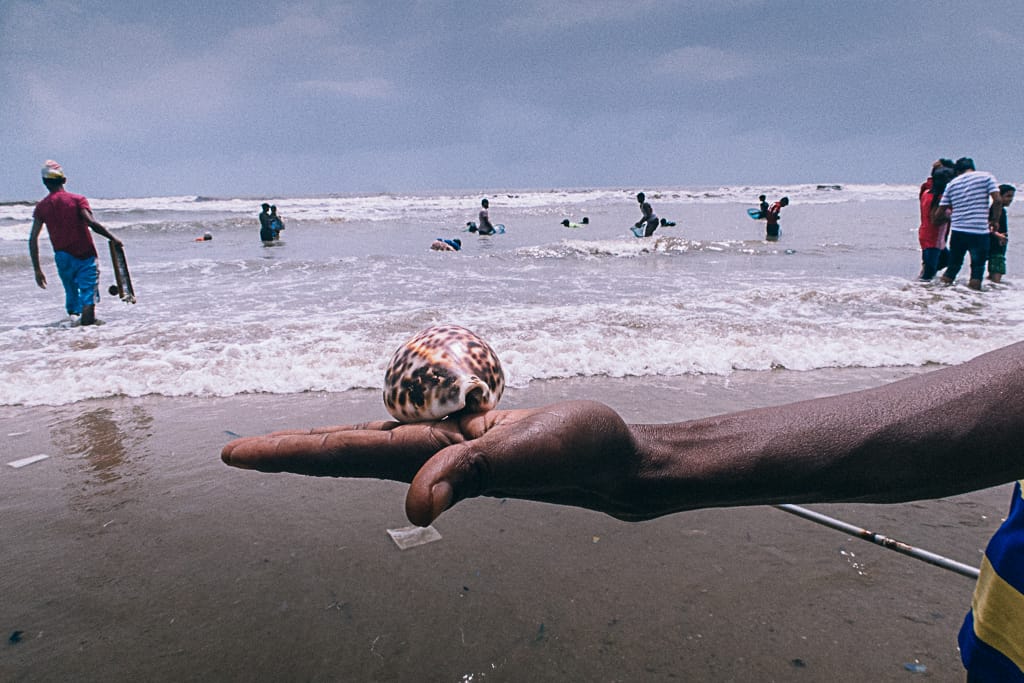
The people and objects are incidental to these places. Their interactions with the shoreline in that moment creates unique scenes and memories.

Sometimes it is the horses and their riders, sometimes it is the locals who harvest shells at the beaches. I have seen people work out at the open gymnasiums at the beaches. Then there are those who come regularly to play, take walk or simply soak in the sunset at the beach.
Beaches tell stories, are we listening?
Today, despite the fact that most of us do not care about the sea or the open vistas it offers, our city’s shores are teeming with life.
Every moment that I capture at the beach, seems to tell a story.
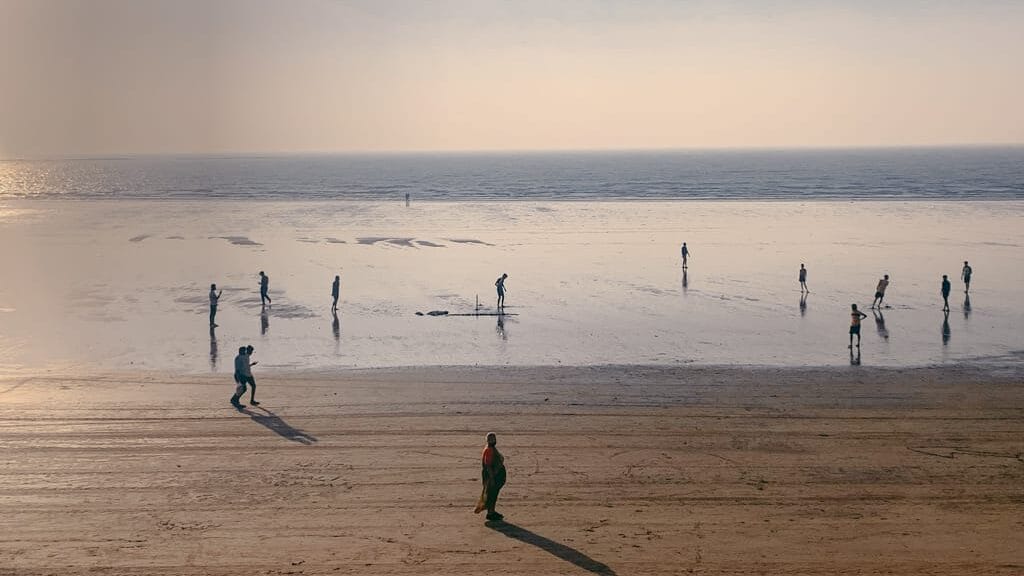
After 10 years of actively going to Mumbai’s beaches, observing and taking pictures, I believe that there’s a universe waiting to be discovered on the shoreline that separates us from the sea.
| Do you have a story to tell about the sea and the beaches of Mumbai? Please share with us at mumbai@citizenmatters.in. |
Also read:
- In photos: what’s left of a gaothan in Vile Parle
- Photos: Inside Mumbai’s iconic 129-year-old BMC building
- Photo essay: The micro-economies of Bhendi Bazaar
Are you a resident of Ramapuram or Alandur, who thinks your ward comes under the Chennai South Parliamentary Constituency? Well, you are wrong!
Knowing the boundaries of the Parliamentary constituencies is important because some of the wards that fall in Greater Chennai Corporation (GCC) limits belong to the suburban parts of Chennai when it comes to Parliamentary voting, which is entirely different when we consider the profile of the urban and suburban areas.
There are 200 wards under 15 Zones in the GCC limit. However, some of the wards in GCC limits fall under the Thiruvallur and Sriperumbudur Parliamentary Constituencies.
Read more: Lok Sabha Elections 2024: Chennai South — Know your constituency and candidates
GCC wards in Chennai’s Parliamentary Constituencies
Here’s a list of the areas in the GCC wards that fall under the three Parliamentary Constituencies in Chennai’s urban limits.
| Parliamentary Constituency | Zone | Wards | Areas included |
| Chennai North | 1– Thiruvotriyur | 1 to 14 | Kaladipettai Kargil Nagar Kathivakkam Thangal Sathuma Nagar Ennore |
| 2 – Manali | 15 to 21 | Kathivakkam Edayanchavadi Kadapakkam Sadayankuppam Theeyambakkam Vadaperumbakkam | |
| 3 – Madhavaram | 22 to 33 | Mathur Puzhal | |
| 4 – Tondiarpet | 34 to 48 | Kodungaiyur Korukkupet Radhakrishnan Nagar Old Washermenpet (Part) Vyasarpadi Perambur | |
| 6 – Thiru.Vi.Ka Nagar | Parts of wards from 64 to 78 | Pulianthope Perambur Choolai |
| Parliamentary Constituency | Zone | Wards | Areas included |
| Chennai Central | 6 – Thiru.Vi.Ka Nagar | Parts of wards from 64 to 78 | Purasaivakkam Kolathur |
| 5 – Royapuram | 49 to 63 | Old Washermenpet (Parts) Muthaiyapettai Chintadripet Pudupet Sowcarpet Egmore | |
7 – Ambattur | 79 to 93 | Tho.Pettai SIDCO Mogappair Korattur Oragadam Kallikuppam Banu Nagar | |
| 8 – Anna Nagar | 94 to 108 | Villivakkam Kilpauk Chetpet Aminjikarai | |
9 – Teynampet | Parts of wards from 109 to 126 | Nungambakkam Thousand Lights Royapettai Alwarpet Chepauk Triplicane |
| Parliamentary Constituency | Zone | Wards | Areas included |
| Chennai South | 9 – Teynampet | Parts of wards from 109 to 126 | Mylapore Santhome Raja Annamalaipuram |
| 10 – Kodambakkam | 127 to 142 | Saligramam Vadapalani Virugambakkam MGR Nagar Ashok Nagar T Nagar Saidapet | |
| 13 – Adyar | 170 to 182 | Guindy Velachery Raja Annamalaipuram Besant Nagar Thiruvanmaiyur | |
| 14 – Perungudi | 183 to 191 168 and 169 | Ullagaram Puzhudhivakkam Madipakkam Kottivakkam Palavakkam Pallikaranai Jalladampettai | |
| 15 – Sholinganallur | 192 to 200 | Neelangarai Okkiyam Thuraipakkam Injambakkam Karapakkam Semmenchery Uthandi |
Zone 3: Madhavaram (parts of Wards from 22 to 33) — which has areas including Chinna Sekadu, Soorapattu, Kadhirvedu and Puthagaram falls under the Thiruvallur constituency.
Zone 11: Valasaravakkam (All areas in Wards – 143 to 155), which has areas including Nolambur, Nerkundram, Maduravoyal, Karapakkam, Porur and Ramapuram comes under the Sriperumbudur parliamentary constituency.
Zone 12: Alandur (All areas in Wards 156 to 167) which has areas including Mugalivakkam, Nandhambakkam, Manapakkam, and Meenambakkam also comes under Sriperumbudur parliamentary constituency.
Read more: Lok Sabha Elections 2024: Chennai North — Know your constituency and candidates
Assembly Constituencies that fall under the Parliamentary Constituencies
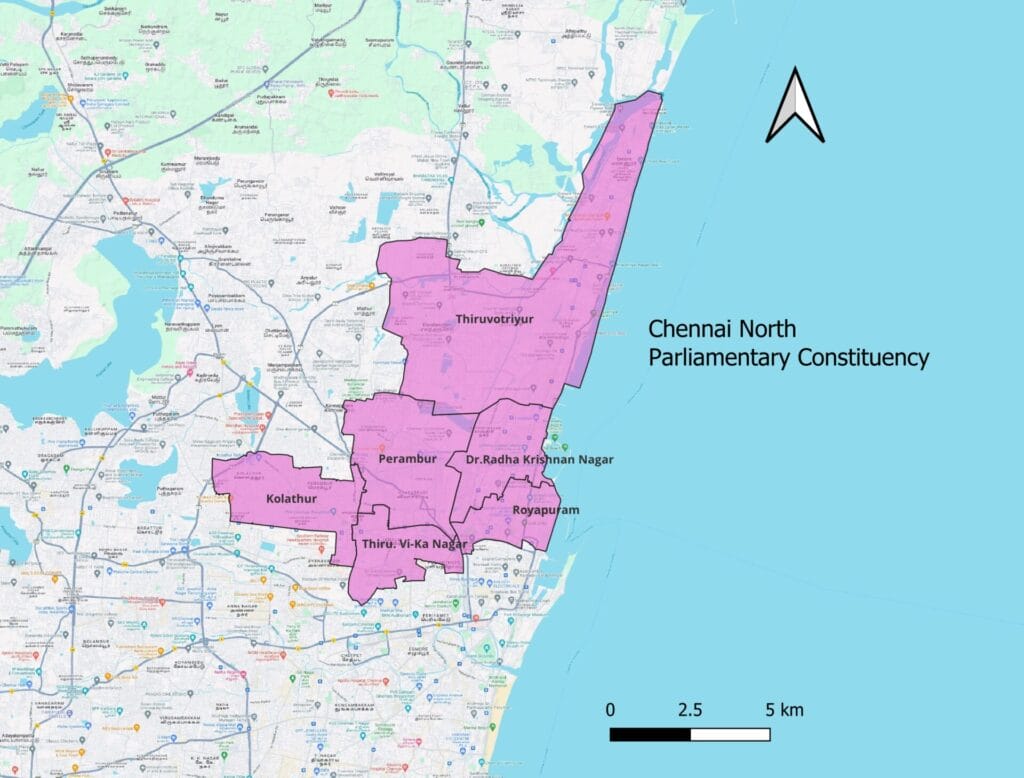


Here is a list of the other Assembly Constituencies in Chennai that fall under each of the Parliamentary Constituencies in the suburban areas of Chennai:
| Parliamentary Constituencies | Assembly Constituencies |
| Thiruvallur | Gummidipoondi Ponneri Thiruvallur Poonamallee Avadi Madhavaram |
| Sriperumbudur | Maduravoyal Ambattur Alandur Sriperumbudur Pallavaram Tambaram |
| Kanchipuram | Chengalpattu Thiruporur Cheyyur Maduranthakam Uthiramerur Kanchipuram |
Find your polling booth
Use your EPIC number in the voter ID cards to find the booth information here.
Also Read:
- Elections 2024: What Chennai residents and civic groups want their MPs to address
- Will push for education reforms including ban on coaching institute ads: Thamizhachi Thangapandian
Being the commercial nerve centre of the city, Chennai Central constituency has a significant population of migrants. From Chennai Metro Water department to the state electricity board and the GST and central excise departments, crucial city, state and central government offices are located in Chennai Central. The constituency is also a hub of healthcare institutions, with more than a dozen prominent government hospitals such as Government Children Hospital, Rajiv Gandhi Government General Hospital and Kilpauk Medical College Hospital located here.
Chennai Central comprises of six assembly constituencies — Villivakkam, Egmore, Harbour, Chepauk-Thiruvallikeni, Thousand Lights and Anna Nagar. Politically, the constituency has always been a DMK stronghold, with DMK leader Murasoli Maran representing the constituency thrice in 1996, 1998 and 1999 and his son Dayanidhi Maran taking over the seat in 2004, 2009 and 2019.
Sandhya Vedullapalli, a civic activist and a long-time resident of Anna Nagar says that the constituency houses planned localities of the city such as Anna Nagar. With abundant greenery and better commute facilities, the constituency was a preferred spot for citizens for residential and commercial purposes.
The constituency boasts a diverse blend of residents, including the city’s wealthiest to its most impoverished neighbourhoods. While Anna Nagar caters predominantly to the upper class, areas like Thousand Lights, Egmore and Villivakkam accommodate a sizeable middle-class population. In contrast, Chepauk-Thiruvallikeni is primarily home to lower-middle-class residents.
The Cooum River, traversing through the constituency, once hosted numerous settlements along its banks. However, the majority of these communities have since been resettled to housing projects on the outskirts of the city.
Demographically, the constituency has a varied socio-economic landscape. According to Ashok K, a resident of Egmore, be it Jains, Muslims or Hindus, citizens from various walks of life can be found in this constituency. Workforce from Ambattur Industrial estate also reside here.

At a glance
| Constituency Name | Chennai Central |
| Number of voters (2019) | 13,32,135 |
| Male voters | 6,60,447 |
| Female voters | 6,71,334 |
| Others | 354 |
Additional info:
- Number of Polling Booths of Chennai Central parliament seat as on 2019 Parliament Election – 1333
- Voters Turnout of Chennai Central parliament seat on 2019 Parliament Election – 58.8%.
Find your polling booth
Use your EPIC number in the voter ID cards to find the booth information here.
Read more: Groundwater resources: Why central Chennai has more than other regions
Key candidates contesting from the Chennai Central constituency
| 2024 | Candidate | Sex | Party | Age | Education | No. of criminal cases | Total assets | Total liabilities |
| 1 | Dayanidhi Maran | Male | DMK | 57 | Graduate | 4 | Rs 17.07 crore | Nil |
| 2 | Parthasarathy B | Male | DMDK | 58 | 10th Pass | 3 | Rs 2 crore | Rs.16.59 lakh |
| 3 | Vinoj P Selvam | Male | BJP | 37 | Graduate professional | 14 | Rs 31.96 crore | Rs.15.50 crore |
The full list of candidates and their affidavits can be accessed from the ECI web portal.
The profile of the incumbent MP from Chennai Central, Dayanidhi Maran can be accessed here.
Past election results
| 2019 | Candidate | Sex | Party | Age | Vote Share (%) |
| 1 | Dayanidhi Maran | Male | DMK | 52 | 57.15 |
| 2 | S. R. Sam Paul | Male | PMK | 41 | 18.77 |
| 3 | Kameela Nasser | Female | MNM | 54 | 11.74 |
| 2014 | Candidate | Sex | Party | Age | Vote Share (%) |
| 1 | S R Vijaya Kumar | M | AIADMK | 40 | 40.8 |
| 2 | Dayanidhi Maran | M | DMK | 47 | 35.2 |
| 3 | J Constandine Ravindran | M | DMDK | 46 | 14.08 |
Candidates in the news
Vinoj P Selvam is contesting for the first time in the Lok Sabha elections. The State President of the Bharatiya Janata Yuva Morcha of the BJP in Tamil Nadu, is being portrayed by the media as the main contender to challenge Dayanidhi Maran, incumbent MP from the DMK party. Recently, while campaigning in Chennai Central, Vinoj told mediapersons that DMK party leaders think that Chennai Central is their property and the constituency has become a symbol of dynastic politics. He was referring to Dayanidhi Maran and his father, Murasoli Maran winning from this constituency multiple times.
Chennai Central has seen no development over the years and its time to give back the constituency to the people, he was quoted as saying. Vinoj has 14 criminal cases against him; while most of them pertain to unlawful assembly, a particular case interestingly refers to charges related to ‘negligent act likely to spread infection of disease dangerous to life.’
The DMDK candidate from Chennai Central Lok Sabha constituency, B Parthasarathy was recently in the news when he alleged that the DMK cadre would take over polling booths in the Chennai Central constituency to forcibly secure a win.
He made a representation to the Election Commission asking the authorities to increase CRPF protection in certain sensitive polling stations and to install CCTV cameras to prevent rigging on April 19 (election day).
Key issues
There are many disparities in the different areas of Chennai Central constituency, but there is a common thread running through all of them — rapid urbanisation. It is this factor that has also made the constituency congested, taking away its soul in the past decade. Despite the Chennai Metro Rail and well-connected bus and local train facilities, traffic congestion is a crucial problem. A few infrastructural lapses such as poor stormwater drain network, lack of pedestrian space, unmilled roads and pollution prevail in many parts of the constituency.
Located close to the Ambattur Industrial Estate, pollution has become a major issue in Anna Nagar. Once a planned locality, it is now turning into a congested hub, affecting the quality of life of the citizens. Besides air pollution, industrial effluents and garbage let out into the water bodies have resulted in water pollution as well.
Read more: Lok Sabha Elections 2024: Chennai South — Know your constituency and candidates
According to Ashok, urgent civic infrastructure upgrades are needed in Egmore, Nungambakkam, Vepery and Kilpauk, where stormwater drains and sewage lines dating back to over 70 years are struggling to cope with the increased density. “Two-edged stormwater drains and new sewage lines should be relaid to address the overflowing issue,” Ashok emphasised. He further recommended the installation of new sewage systems, including an extended pumping system, to effectively manage the growing demand.
Residents of Villivakkam are grappling with water supply issues, with complaints about dark and murky water being supplied by Metro Water, resembling sullage. “Why else are we paying our taxes?” questioned Liliyan Swarnakalai (65), a resident, who shared her frustration: “I purchase eight cans per month, spending Rs 80 per can of 20 litres. For cooking, I spend Rs 50 for one can of cooking water of 20 litres. Only after the recent monsoon, we are unable to use water. It is also mixed with sewage water. This is not a one-off problem as it happens once every few years.”
This reliance on canned water highlights the failure of the municipal water supply system to meet the basic needs of the residents.
The Tamil Nadu government launched the Chennai River Restoration Trust in 2006 to revive Cooum and Adyar rivers. Once a lifeline for Chennai, Cooum is now deemed a dead river by the Tamil Nadu Pollution Control Board.
“Despite various strategies and establishing a dedicated body, Cooum restoration is moving at a snail’s pace. Sewage contamination, industrial effluents, garbage dumpage – the river is killed with every sort of pollution and it is unacceptable,” said E Arun, a resident of Chepauk, who says that the new MP should come up with a different strategy to revive the water body at the earliest.
According to Shweta Kumari, a health activist the state of government hospitals in the constituency should be improved for better public health care.
Several new projects have been launched at the government hospitals in the city and they have adopted technology like the introduction of robotics at Omandurar Government Hospital. The new block of Kilpauk Medical College Hospital and several new units at Rajiv Gandhi hospital have indicated infrastructure development in public hospitals. However, these hospitals are still overcrowded and the service needs to be improved, feels Shweta.
Also read:
- Lok Sabha Elections 2024: Chennai North — Know your constituency and candidates
- Will push for education reforms including ban on coaching institute ads: Thamizhachi Thangapandian
- Name: Manoj Kotak
- Constituency: Mumbai North East
Manoj Kotak started working for the Bhartiya Janata Party (BJP) in 1989. Before being elected as an MP from the Mumbai North East constituency in the 17th Lok Sabha elections (2019), he served as a Municipal Corporator from Mulund from 2007 to 2019.
In the 2019 elections, Manoj Kotak got 56.61 percent of the total of 9,09,181 votes cast, getting 5,14,599 votes. He defeated his nearest rival, Sanjay Dina Patil of the NCP by 2,26,486 votes. Kotak was chosen to contest the elections instead of popular leader Kirit Somaiya, who was reportedly gearing for a second term.
The Mumbai North East constituency comprises of densely populated areas such as Mulund, Vikhroli, Ghatkopar and Mankhurd. The constituency has a strong Gujarati population, who have overwhelmingly supported the BJP in the past two general elections.
Who is Manoj Kotak?
| Name | Manoj Kotak |
| Age | 46 years |
| Political Party | BJP |
| Educational Qualification | SSC |
| Profession | Social Worker |
| Enrolled as Voter in | 155, Mulund Assembly (Maharashtra) constituency, at Serial no 863 in Part no 42 |
| manojkotak@hotmail.com, manoj.kotak@sansad.nic.in | |
| Contact Number | (011) 23094740, 23094741, 09821163742 (M) |
| Address | 1201, BPS Aakarshan, Murar Road, Near Kalidas Hall, Mulund West, Mumbai-400080, Maharashtra. |
Online presence:
- Website: https://manojkotak.in/
- Facebook: https://www.facebook.com/ManojKotakBJP
- Instagram: https://www.instagram.com/manojkotak_bjp/
- YouTube: https://www.youtube.com/@PCMohanBJP
- Twitter: @manoj_kotak
Read more: General Elections 2024: Voter awareness and accurate registration crucial
Criminal cases against Manoj Kotak
Manoj Kotak has one criminal case pending against him. He has been convicted in one case. Following are the charges against him in these cases:
- charges related to Voluntarily causing hurt by dangerous weapons or means (IPC Section-324)
- charges related to Voluntarily causing grievous hurt by dangerous weapons or means (IPC Section-326)
- charges related to Punishment for wrongful Confinement (IPC Section-342)
- charges related to Intentional insult with intent to provoke breach of the peace (IPC Section-504)
- charges related to Acts done by several persons in furtherance of common intention (IPC Section-34)
- charges related to Punishment for voluntarily causing hurt (IPC Section-323)
Source: myneta.info
Read more: Mumbai North-East candidates: Ruling party rookie takes on opposition’s old hand
Assets and liabilities
| Details | Holdings in 2019 |
| Movable assets | Rs 1,97,07,465 |
| Immovable assets | Rs 3,49,54,479 |
| Total Assets (Movable + Immovable) | Rs 5,46,61,944 |
| Liabilities | Rs 20,48,000 |
Previously, in 2016, when Manoj Kotak filed his affidavit for the biennial election to the Maharashtra State Legislative Assembly, his movable assets amounted to Rs, 1,79,21,254 and his immovable assets amounted to Rs. 2,38,85,535. The total amounted to Rs. 4,18,06,789. His liabilities were mentioned Rs. 1,13,78,092.
Positions held by Manoj Kotak
- In 17th Lok Sabha:
- Member, Standing Committee on Commerce
- Member, Standing Committee on Finance
- Member, Consultative Committee, Ministry of Shipping
- 2007 – 2019: Corporator, Municipal Corporation of Greater Mumbai (MCMG), (Three terms)
Read more: Lok Sabha 2024: Know your MP – Gopal Shetty, Mumbai North
Performance of Manoj Kotak in Parliament
Manoj Kotak had very good track record in attendance, clocking 100% attendance in all the sessions except for the winter session of 2022 where his attendance was 92% and the budget session of 2022 where his attendance was 85%. His attendance was well over the national average of 79% and the state average of 74%.
| MP | Attendance | No of Debates participated | No of questions asked | Private Member’s Bill |
| Manoj Kotak | 98% | 53 | 367 | 7 |
| National average | 79% | 46.7 | 210 | 1.5 |
| State (Maharashtra) average | 74% | 57.6 | 386 | 2.9 |
He participated in 53 debates, which included topics such as the development of a flamingo bird watching park and tourist spot at Bhandup, the need to make boarding and deboarding facilities in Mumbai local trains disabled-freindly, and the need to run 15-coach local trains on the Mumbai suburban railway network.
He also raised the issue of water logging and delay in central suburban trains in Mumbai. Besides this, he requested the government to provide assistance to the BMC and the state government to prevent the outbreak of measles as well as to work on cases of malnutrition.
Questions in Parliament
Manoj Kotak asked 367 questions in Parliament, higher than the national average of 210 but lower than the state average of 386. He asked the Minister of Home Affairs for the details of the heinous crimes which have been committed in 2019-20, specially in Maharashtra, the manner in which the ‘Nirbhaya Fund’ has been used for the protection of women and the results of the same.
He also asked the Minister of Environment, Forest and Climate Change whether steps had been taken to protect the fragile coastline ecosystems in Maharashtra and to create a sustainable management system for the use of coastal and marine resources. He asked the Minister of Railways whether the railways proposes to offer private players the chance to run 150 modern trains on a revenue sharing basis and the details of the same. He asked the Minister of Communication whether the government is going to introduce 5G services for the improvement of Digital India, a government-run programme, and the details of the same.
The full list of the questions is available here.
Manoj Kotak introduced 7 Private Member’s Bills. The following is a list of the same:
- The Prohibition of Fake News on Social Media Bill, 2023
- The Urban Areas (Development and Regulation) Bill, 2023
- The Waste (Disposal and Management) Bill, 2023
- The Over the Top Platforms Regulatory Authority Bill, 2021
- The Establishment of Special Schools for Mentally Retarded Children Bill, 2019
- The Pre-School Regulatory Authority Bill, 2020
- The Welfare of Families of Defence Personnel Bill, 2020
MPLADS spending of Manoj Kotak
Manoj Kotak used his funds for addressing infrastructural challenges such as poor drainage systems and road repairs. His website talks about projects such as initiation of cycle track from Mulund to airport, upgradation of crematorium, zero garbage ward and organisation of Nav Ratri Festival, but it is not clear if they are executed from MPLADS fund.
| Recommended amount | Rs 7.89850000 cr |
| Utilised amount | Rs 7.730000 cr |
| Balance | Rs 0.16850000 cr |
Manoj Kotak in news
Manoj Kotak introduced a private member’s bill called Prohibition of Fake News on Social Media Bill, 2023′. The bill proposes an imprisonment of up to 7 years or a fine of up to Rs. 10 lakh, or both for spreading fake news. He has spoken about PM Narendra Modi in glorious terms, saying that under his governance India has become free of terror attacks and has strengthened its economic standing.
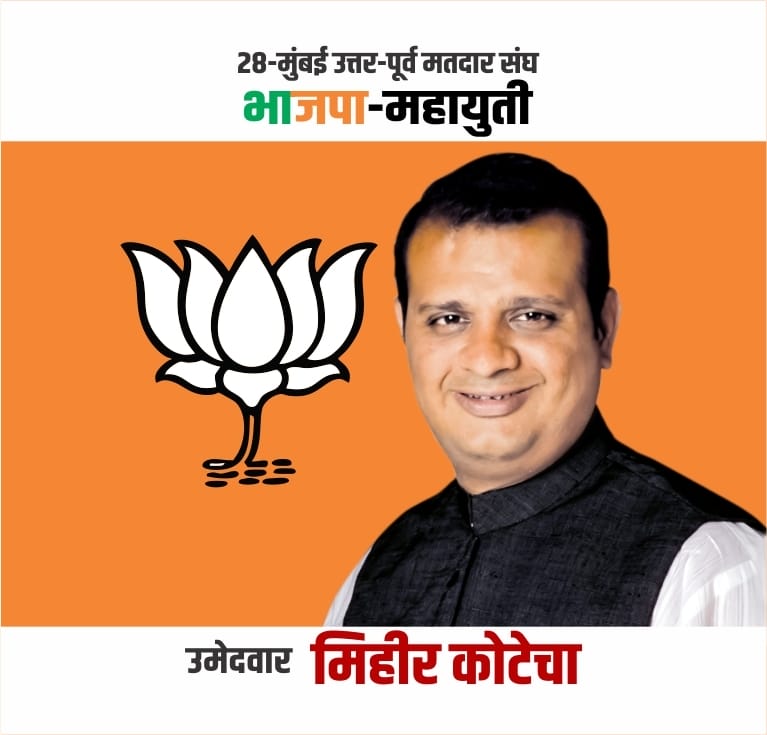
Manoj Kotak has not been given a ticket by the BJP for the upcoming 2024 Lok Sabha elections. Instead, Mihir Kotecha, the MLA from Mulund has been selected to contest elections from the Mumbai North East constituency.
